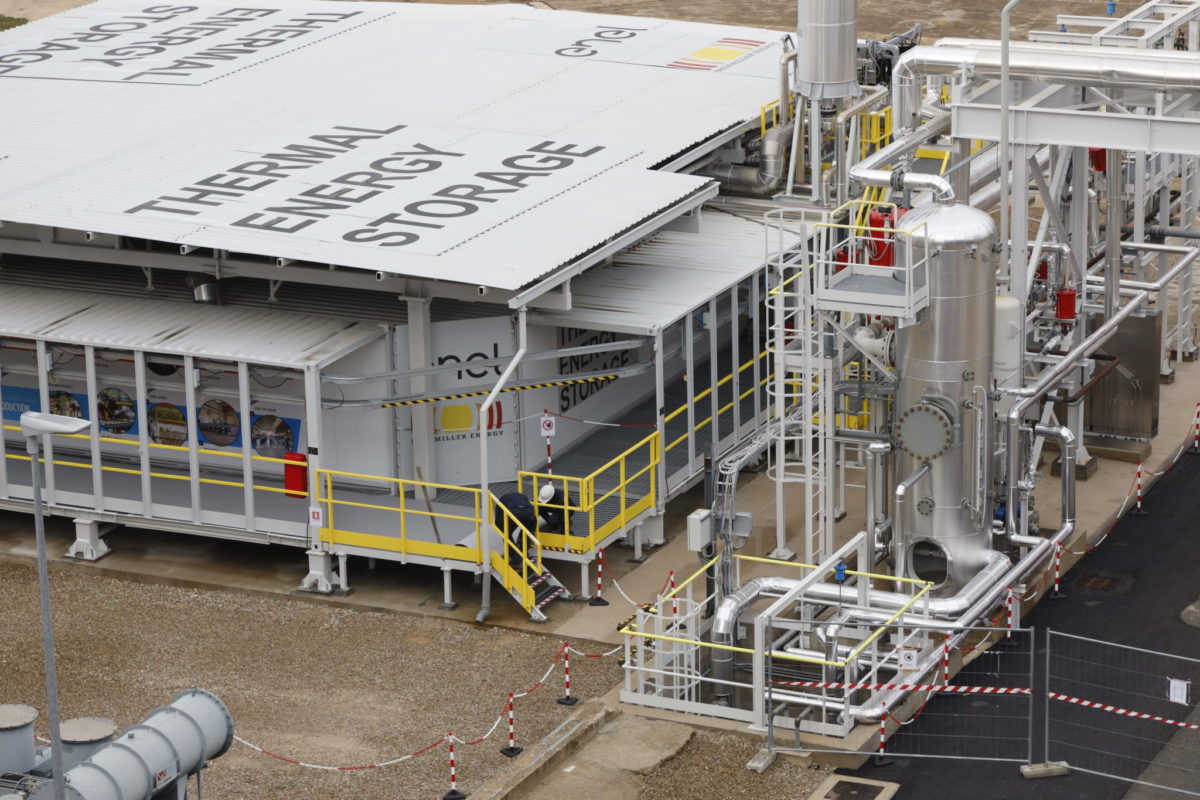From pv magazine Global
Italian energy group Enel has commissioned a rock-based thermal storage system (TES) in Tuscany, Italy.
The plant is based on Brenmiller Energy’s storage technology. The Israel-based company’s system uses rocks that store excess energy as heat, then releases that heat to generate steam for electricity. The system has a capacity of about 24 MWh of thermal capacity and can be fully charged and discharged in about five hours.
“In this first-of-a-kind application, the TES is integrated with a combined cycle gas turbine power plant to partially decouple production from the gas turbine and the bottoming steam cycle,” said Nicola Rossi, head of innovation at Enel’s renewable energy unit, Enel Green Power. “The TES is charged by steam coming from the heat recovery steam generator (HRSG).”
Rossi said the aim is to increase the overall flexibility of the thermoelectric plant, which means having faster ramp-up rates, reducing minimum load, and having faster startup times from warm conditions.
“In this way, the plant can offer more services to the grid, thus increasing the overall renewable energy hosting capacity of the electrical system,” he said.
They use high-pressure steam at around 9 tons per hour at 550 C and 80 bar to charge the TES during the charging phase. Condensate coming out of the TES goes back to the steam cycle at a degasator. During the discharging phase, 150 C water feeds the TES at around 6 tons per hour. The intermediate pressure steam then goes back to the HRSG to feed the intermediate pressure steam turbine stage at 360 C.
“[This] will allow for the technology to be tested in very challenging conditions,” Rossi said. “In the future, the system will be charged electrically through resistors fed by solar and wind power plants. The heat accumulated in the system will be then used to feed industrial sectors that need heat for their production processes and that today use gas to produce the required heat, or to generate electricity”
Enel believes that the most interesting business case for the system would be using it for electrification purposes, to make heat demand from industrial customers more flexible.
“The TES will be used both as power-to-heat equipment and a thermal storage,” Rossi said. “In fact, TES technologies already have a configuration that uses a direct electric charge with resistors instead of steam during the charging phase. Therefore, the TES matches a renewable energy generation profile and the heat demand profile, supporting 24/7 full decarbonization.”
Enel says another interesting application is that the TES replaces a conventional boiler in phased-out thermal power plants.
“In this configuration, an electrically charged TES integrated with the plant’s existing power island, including turbines, generator, condenser and other main equipment, represents a real power-to-power energy storage system, that despite the lower efficiency, offers a competitive solution in terms of levelized cost of storage (LCoS) for long durations of over eight hours and very large-scale applications of hundreds of MWh up to GWh,” it said.
TES could also be an interesting technology for hybridizing different generation assets, according to the company.
“For instance, heat accumulated by PV or wind in peak production hours could be reinjected in existing plants such as geothermal plants to produce more energy during demand peak hours,” Rossi said. “In all the above-mentioned future applications, the TES could be directly coupled with RES (PV or other) or connected to the grid and using other tools like PPAs to manage the charging phase.”
This content is protected by copyright and may not be reused. If you want to cooperate with us and would like to reuse some of our content, please contact: editors@pv-magazine.com.









By submitting this form you agree to pv magazine using your data for the purposes of publishing your comment.
Your personal data will only be disclosed or otherwise transmitted to third parties for the purposes of spam filtering or if this is necessary for technical maintenance of the website. Any other transfer to third parties will not take place unless this is justified on the basis of applicable data protection regulations or if pv magazine is legally obliged to do so.
You may revoke this consent at any time with effect for the future, in which case your personal data will be deleted immediately. Otherwise, your data will be deleted if pv magazine has processed your request or the purpose of data storage is fulfilled.
Further information on data privacy can be found in our Data Protection Policy.